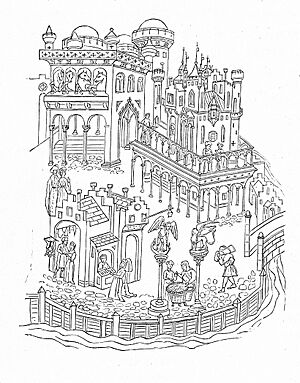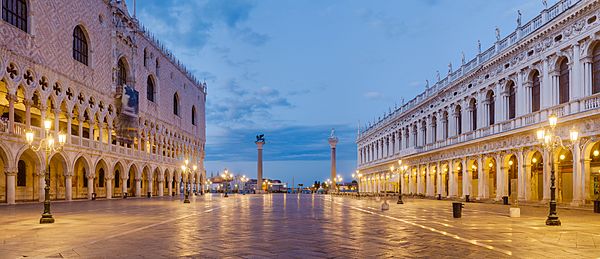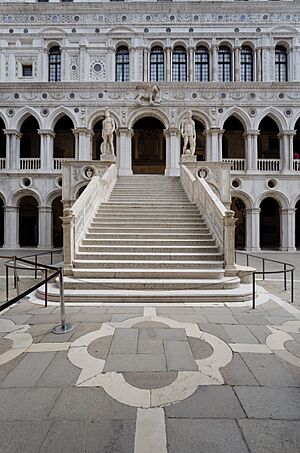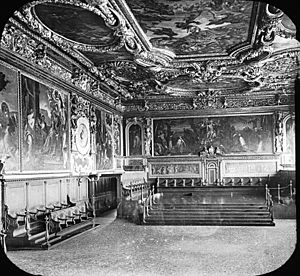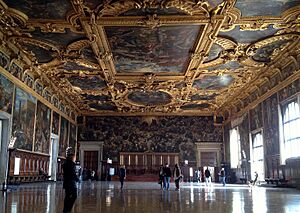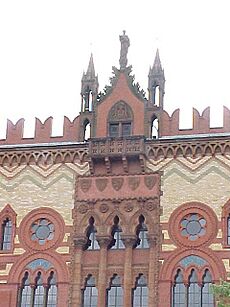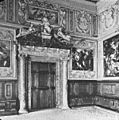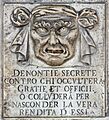Doge's Palace facts for kids
| Palazzo Ducale (Italian) / Pałaso Dogal (Venetian) | |
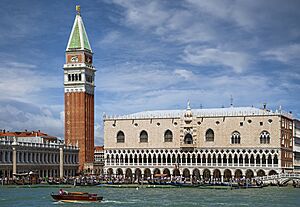
The Doge's Palace facing the lagoon
|
|
| Established | 810, reconstructed 1340 |
|---|---|
| Location | Piazza San Marco 1, 30124 Venice, Italy |
| Type | Art museum, Historic site |
| Visitors | 1.4 million (2018) |
The Doge's Palace (pronounced "dohj") is a beautiful palace in Venice, northern Italy. It was built in a special style called Venetian Gothic. This palace was once the home of the Doge of Venice, who was the elected leader of the old Republic of Venice. It also held government offices and even a jail.
The palace was first built in 810. It was rebuilt in 1340 and changed many times over the years. Since 1923, it has been a museum. It is now one of 11 museums managed by the Fondazione Musei Civici di Venezia.
Contents
The Palace's Story
In 810, the Doge Agnello Participazio decided to move the government to the area where the palace stands today. He wanted a "ducal palace" built there. However, that first building was mostly destroyed by a fire in the 10th century.
Later, Doge Sebastiano Ziani (1172–1178) started new building work. He changed the whole area around St. Mark's Square. The new palace was built like a fortress. You can still see some old parts from this time, like the stone base and brick patterns.
Around 1340, a new Gothic palace began to be built. This was because the number of members in the Great Council (a big government group) had grown a lot. Doge Francesco Foscari later extended the building. He added the famous Porta della Carta in 1442.
In 1483, a big fire damaged the Doge's living areas. Antonio Rizzo then rebuilt it, adding new Renaissance styles. More fires happened in 1547 and 1577. The 1577 fire was very bad, destroying important rooms and artworks. Even so, people decided to keep the original Gothic style when rebuilding.
The palace was the center of Venice's government until 1797. That's when Napoleon took over the city. After that, Venice became part of France, then Austria, and finally Italy in 1866. The palace was used for different government offices and cultural groups.
By the late 1800s, the palace was falling apart. The Italian government spent a lot of money to fix it. In 1923, it officially became a museum. Since 1996, it has been part of a network of Venetian museums.
What the Palace Looks Like
Outside the Palace
The oldest part of the palace faces the lagoon. Its corners have sculptures from the 1300s. The arches and loggia (an open gallery) are decorated with beautiful carvings. Many of these were replaced with copies in the 1800s to protect the originals.
The Porta della Carta (Paper Gate) was built between 1438 and 1442. It was the main entrance for ceremonies. Its name might come from public writers who worked nearby. The gate has Gothic spires and statues. A statue of Justice stands at the top. Below it, a 19th-century sculpture shows Doge Francesco Foscari kneeling before the Lion of Saint Mark.
Today, visitors enter the Doge's Palace through the Porta del Frumento, which is on the waterfront side.
Inside the Courtyard
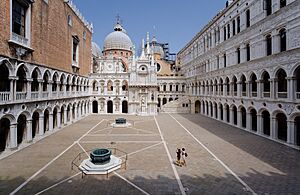
The north side of the courtyard connects the palace to St Mark's Basilica, which used to be the Doge's private chapel. In the middle of the courtyard are two old well-heads from the mid-1500s.
In 1485, a grand staircase was built in the courtyard. It's called the Giants' Staircase because of the two huge statues of Mars and Neptune at its top. These statues, made by Sansovino in 1567, represent Venice's power on land and at sea.
The Opera Museum
The Doge's Palace has been repaired and rebuilt many times over the centuries. Fires, damage, and new needs meant there was always work being done. From the Middle Ages, a "technical office" called the Opera was in charge of all these repairs.
By the late 1800s, the palace was in very bad shape. A big restoration project started in 1876. Many of the old carvings and capitals (the tops of columns) were removed and replaced with copies. The original pieces, some of them true masterpieces, were put into a special area. This area is now the Museo dell'Opera.
After careful restoration, these original sculptures are now displayed in six rooms of the museum. You can also see parts of an ancient stone wall there, which is a remnant of an even older version of the palace.
The Doge's Home
The Doge's private rooms were always in a specific part of the palace. This area was near the Golden Staircase and the St. Mark's Basilica. A fire in 1483 meant these apartments had to be rebuilt, and they were finished by 1510.
The Doge's apartments were fancy but not huge. Some rooms were used for both private life and official duties. In his private rooms, the Doge could relax and eat with his family. When a Doge died, his furniture was removed to make space for the next elected Doge's belongings.
- The Scarlet Chamber might be named after the red robes worn by the Doge's advisors. It has a carved ceiling with the coat-of-arms of Doge Andrea Gritti.
- The "Scudo" Room got its name from the Doge's coat-of-arms (scudo means shield) that was displayed here. This was the largest room in the Doge's apartments. It was used for receiving guests. Its maps showed Venice's great history and power.
- The Erizzo Room is named after Doge Francesco Erizzo. It has a carved wooden ceiling and a fireplace.
- The Stucchi or Priùli Room has two names. One comes from the stucco decorations on its ceiling. The other comes from the coat-of-arms of Doge Antonio Priuli on the fireplace. This room has paintings about the life of Jesus Christ. It also has a portrait of King Henry III of France.
- The Philosophers' Room was once home to twelve paintings of ancient philosophers. Now it has other artworks. A secret staircase here allowed the Doge to quickly reach the upper floors for meetings. A fresco of St. Christopher by Titian is also in this room.
- The Corner Room is named after Doge Giovanni I Cornaro. It has a fireplace made of Carrara marble. This room was for the Doge's private use.
- The Equerries Room was the main entrance to the Doge's private apartments. Equerries were special assistants to the Doge.
Government Rooms
- The Square Atrium was a waiting room before entering other important halls. Its decorations are from the 1500s.
- The Four Doors Room was a formal waiting area for important meetings. Its four doors are made of beautiful marbles. The paintings show Venice's history and power. A famous painting by Tiepolo shows Venice receiving gifts from Neptune.
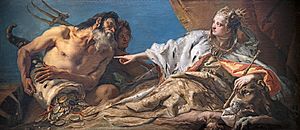
- The Antechamber to the Hall of the Full College was where foreign visitors waited. It was restored after a fire in 1574. A central painting by Veronese shows Venice giving out honors.
- The Council Chamber was where the Full College met. This group helped organize the Venetian Senate and dealt with foreign affairs. The ceiling paintings by Veronese celebrate good government and virtues.
- The Senate Chamber was also called the Sala dei Pregadi. The Senate was an old institution that managed Venice's money, trade, and foreign policy. Paintings in this room often show Christ, protecting the Senate's decisions.
- The Chamber of the Council of Ten is named after a special council formed after a secret plan in 1310. This council was very powerful. Its ceiling shows gods and symbols of justice.
- The Compass Room was used for justice. Its name comes from a large wooden compass that hides the entrance to rooms for powerful judges. People waited here to be called by these judges. From here, you could go to the Armoury or the New Prisons.
- The Liagò was a glass-enclosed balcony. It was a place for members of the Great Council to meet and talk between their discussions.
- The Chamber of Quarantia Civil Vecchia was one of three councils that dealt with civil law.
- The Guariento Room is named after a fresco painted by Guariento around 1365. Most of it was destroyed in the 1577 fire. What was left was found under a large painting called Il Paradiso by Tintoretto.
- The Chamber of the Great Council is the largest room in the Doge's Palace and one of the biggest in Europe. It is 53 meters long and 25 meters wide. All male members of noble Venetian families over 25 years old met here. After the 1577 fire, artists like Veronese and Tintoretto redecorated it. The walls show scenes from Venetian history. A frieze (a long band of decoration) has portraits of the first 76 doges. Doge Marino Faliero, who tried to take over the government, is shown as a black cloth because he was seen as a traitor. The longest canvas painting in the world, Il Paradiso by Tintoretto, is on one of the long walls.
- The Scrutinio Room was originally a library. Later, it was used for counting votes during elections. Its decorations show military victories of Venice.
- The Quarantia Criminale Chamber and the Cuoi Room were used for dealing with laws about crimes.
- The Magistrato alle Leggi Chamber housed officials who made sure laws were followed.
- The State Censors were like moral advisors. They tried to stop cheating in elections and protect government groups.
- The State Advocacies' Chamber has paintings of officials called Avogadori. They made sure laws were applied correctly and checked if noble families were truly noble.
- The "Scrigno" Room held two important books: the Golden Book and the Silver Book. These books listed noble families and those who could work for the state.
- The Chamber of the Navy Captains was where a group called the Milizia da Mar met. They were in charge of finding crews for Venice's warships.
Old Prison or Piombi
Before the 12th century, there were cells inside the Doge's Palace. More prison spaces were added over time. Some cells on the ground floor were dark and damp, known as the Pozzi (the Wells). In 1591, more cells were built directly under the lead roof. These were called the Piombi (meaning "leads"). Famous prisoners included Giacomo Casanova, who wrote about escaping through the roof.
Bridge of Sighs and the New Prisons
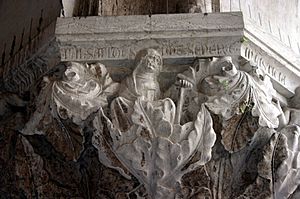
The Bridge of Sighs was built in 1614. It connects the Doge's Palace to the New Prisons. The bridge is covered and has two separate corridors. Visitors today use one corridor that linked the prisons to the courtrooms.
The bridge's famous name comes from the Romantic period. People imagined prisoners sighing as they crossed it, taking a last look at freedom through the small windows before going to their cells. The New Prisons were built to be better for prisoners, with larger, brighter cells. However, some parts of the new prisons were still not very good.
On October 9, 1991, a painting called Madonna col bambino was stolen from the palace. A man named Vincenzo Pipino hid in a prison cell after a tour group left. He then crossed the Bridge of Sighs at night to reach the room where the painting was. The painting was recovered by the police on November 7, 1991.
Palace Look-Alikes Around the World
Azerbaijan
The Ismailiyya building in Baku, Azerbaijan, looks like the Doge's Palace. It is now used by the Academy of Sciences of Azerbaijan.
Romania
The Central rail station in Iași, built in 1870, was also inspired by the Doge's Palace.
United Kingdom
Many buildings in the United Kingdom from the 1800s copied the palace's style. Some examples are:
- the Wool Exchange, Bradford
- the Wedgwood Institute, Burslem
- the Scottish National Portrait Gallery, Edinburgh
- the Templeton's Carpet Factory, Glasgow
These buildings were influenced by the ideas of John Ruskin. He wrote a book called The Stones of Venice in the 1850s.
United States
19th-century Copies
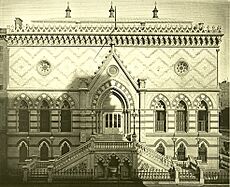
The Montauk Club in Park Slope, Brooklyn (1889) has parts that look like the palace. The Bush Street Temple in San Francisco, built in 1895, has a front that copies the Doge's Palace. The outside of the Chicago Athletic Association building (1893) is also based on the palace.
20th-century Copies
The Hall of Doges at the Davenport Hotel in Spokane, Washington copies the palace's fancy Gothic style. The front of the Italy Pavilion at Epcot in Orlando, Florida, also looks like the Doge's Palace. The palace is also copied at The Venetian Las Vegas and The Venetian Macao resorts.
21st-century Copies
The Doge's Palace was created in the 2009 video game, Assassin's Creed II. In the game, the main character flies into the palace to stop a plot.
Images for kids
See also
 In Spanish: Palacio Ducal de Venecia para niños
In Spanish: Palacio Ducal de Venecia para niños
- List of buildings and structures in Venice


